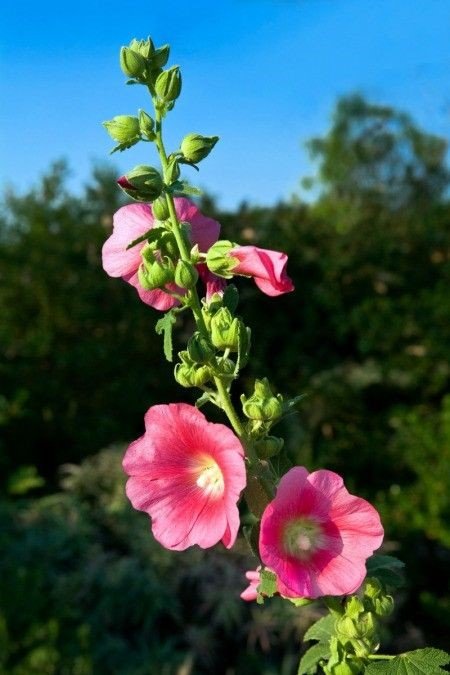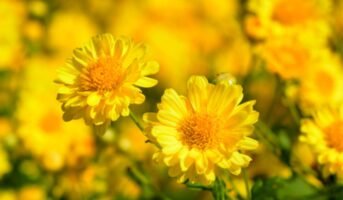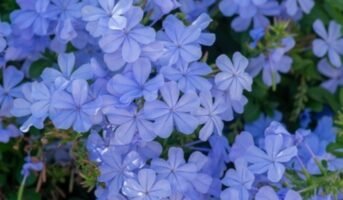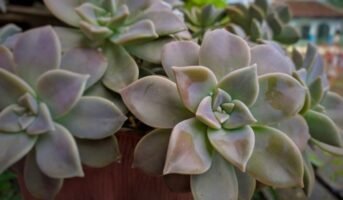Alcea is a genus containing more than 80 species of flowering plants in the Malvaceae family, also known as the hollyhocks. They are indigenous to Europe and Asia. Majority of the most popular varieties are biennials, which means they go through their entire life cycle in two years. The first year is dedicated to storing energy and producing foliage. The stalks extend higher in the second year, blooms open, and seeds begin to grow. But, there are also several types that, when planted early enough in the spring or started indoors in winter, act like short-lived perennials and bloom in their first year.

Source: Pinterest
See also: Crossandra flowers: How to grow and care for them?
Hollyhock: Facts table
| Common Name | Hollyhock |
| Genus Name | Alcea rosea |
| Plant Type | Perennial, biennial |
| Flower Colour | Blue, Orange, Pink, Purple, Red, White, Yellow |
| Foliage Colour | Blue/Green |
| Propagation | Division, Seed |
| Height/Spread | 6-8 feet tall, 1-2 feet wide |
| Sunlight | Full sun to part shade |
| Bloom time | June-August |
Hollyhock: Description
Hollyhocks are tall, unbranched plants that can be annual, biennial, or perennial. Often, the herbage is covered in hairs that resemble stars. The leaf blades are carried on long petioles and may have lobed edges or teeth. The upper portion of the stalk bears solitary or double, cup-shaped flowers that are at least 7.5 cm (3 inches) across. They bloom on long spikes and have a thin or no stalk.
Blue, pink, purple, red, white, yellow, and even black are just a few of the many colours that hollyhocks may be found in. From top to bottom, the long spikes are completely encircled with blossoms. The leaves of hollyhocks are big, rough, and palmately shaped. The fruit is a schizocarp, a seed-containing dry disc that is divided into over 15 sections.
Hollyhock: How to plant?
Hollyhocks can be easily started from seed both indoors and outdoors. Here’s how and when to do it.
A week before the final frost, seeds can be sown immediately outside. About 1/4 inch deep and about 2 feet apart, sow them. Because of their lengthy taproots, hollyhocks should be started indoors in tall, separate pots and transplanted as soon as possible to prevent damage. 9 weeks before the last average frost date, start indoor seedlings. After the final frost, seedlings can be transplanted outdoors two to three weeks later. Remember that some plants are biennials and might not bloom until their second year.
Where to plant?
Plant in a location with full to partial light and good drainage. Provide support in the form of a fence, wall, trellis, or stake to shield them from wind damage due to their height. Place hollyhocks in a location where self-seeding won’t be an inconvenience because, if left to their own devices, they will do so effortlessly.
Hollyhock: How to care?
Water
For hollyhock seedlings or plants, provide regular irrigation and maintain soil moisture. They are quite drought tolerant after they have established themselves, though. Avoid soaking the foliage when you are watering; doing so can cause damaged leaves. Instead, water from below.
Sunlight
Make sure you have a sunny garden bed because hollyhocks do best in full sun, whether they are growing outside or inside. Hollyhocks can tolerate some shade as long as they get at least six hours of direct sunlight each day, but the more direct sunlight they get, the more robust your hollyhock flower blossoms will be.
Soil
Hollyhocks need rich, wet soil that drains well. Hollyhocks are tolerant of a wide range of soil types. While hollyhock will grow in clay as well, it prefers a location with well-drained soil. These towering flowers will grow on soil that is neutral, acidic, or alkaline, thus pH is not a key factor. Avoid winter soil that is too damp.
Temperature and humidity
Growing conditions call for daytime temperatures of 70°F or higher and evening lows of at least 60° to 65°F. Hollyhock is particularly susceptible to rust in extremely hot and muggy conditions, and the situation usually gets worse as the summer wears on. Early in the summer, before they have been affected by the weather, these erect blooms likewise exhibit their greatest appearance.
Fertiliser
When you first plant hollyhock, enriching the soil with a slow-release fertiliser can help in its growth. As the plant reaches maturity, you shouldn’t need to fertilise anymore (although you can).
Pruning
Remove any dead or withering foliage throughout the growing season, especially any leaves that have rust infections. The hollyhock spikes can be pruned to the ground once the flowers have lost their beauty.
Propagation
The best and simplest way to cultivate hollyhocks is from seed, and if the flower stalks are left in place, they will easily self-seed.
Diseases and pests
They are susceptible to hollyhock rust, a fungus that starts as yellow spots on leaves before turning into brown or rust-coloured pimples on the underside of the leaves. It is considerably simpler to prevent rust than to control an outbreak. Rust can be prevented to a large extent by watering from below, maintaining adequate air circulation, and doing thorough fall cleanup. To stop the rust from spreading further, any leaves that exhibit symptoms should be plucked from the plant and thrown away.

Source: Pinterest
Hollyhock: Uses
- Hollyhocks are popular garden ornamental plants.
- In addition to the roots, seeds, stems, leaves, and flowers of hollyhocks being used medicinally, their stems can be used as fuel.
- Hollyhock is used to treat pain, stomach ulcers, bleeding in the intestines or stomach, stomach swelling (gastritis), cancer, eczema (atopic dermatitis), diabetics who have foot ulcers, Hyperlipidemia, or having too much cholesterol or other fats in the blood, kidney stones, venous leg ulcers, wound healing, diabetes, and many other ailments could all benefit from this treatment, but there isn’t any solid scientific proof to back it up.
- Hollyhock may reduce blood sugar levels and impair the ability to control blood sugar levels before, during, and after surgery. Before any scheduled surgery, stop taking hollyhock at least two weeks in advance.
Hollyhock: Toxicity
Although hollyhock plants are not toxic, the stems and leaves can irritate the skin when touched or brushed against due to the presence of tiny glass-like fibres. If touched, the resin produced by this plant can lead to dermatitis. Hollyhock contact can result in rashes in both humans and animals. If you suspect Hollyhock poisoning, always seek advice from your doctor or veterinarian.
FAQs
Where do hollyhock plants thrive?
Although hollyhocks may grow in any type of garden soil, they prefer fertile, well-drained soil that receives direct sunlight to produce the longest flower spikes. They tend to blow over, so pick a spot that is protected from severe winds.
Are hollyhock blooms edible?
Many people are unaware that the typical garden flower, the hollyhock, is entirely edible, including the roots, leaves, and blooms, and excellent for purposes other than merely pretty appearances.
| Got any questions or point of view on our article? We would love to hear from you. Write to our Editor-in-Chief Jhumur Ghosh at jhumur.ghosh1@housing.com |
Housing News Desk is the news desk of leading online real estate portal, Housing.com. Housing News Desk focuses on a variety of topics such as real estate laws, taxes, current news, property trends, home loans, rentals, décor, green homes, home improvement, etc. The main objective of the news desk, is to cover the real estate sector from the perspective of providing information that is useful to the end-user.
Facebook: https://www.facebook.com/housing.com/
Twitter: https://twitter.com/Housing
Email: editor@housing.com











